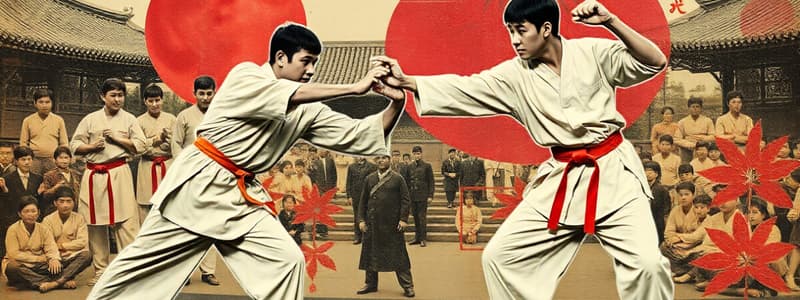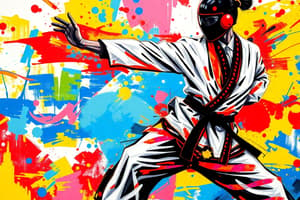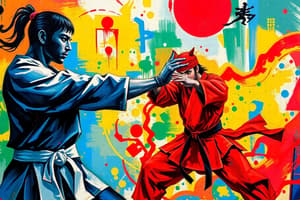Podcast
Questions and Answers
What is the primary aim of the martial arts system inspired by five animals?
What is the primary aim of the martial arts system inspired by five animals?
- To enhance combat skills
- To teach postural awareness for horseback riding
- To provide meditation techniques
- To stimulate circulation and strengthen health (correct)
Which of the following is NOT one of the animals represented in the '5-animal' martial arts system?
Which of the following is NOT one of the animals represented in the '5-animal' martial arts system?
- Lion (correct)
- Crane
- Tiger
- Deer
What unique feature does the Siao-Lao system incorporate?
What unique feature does the Siao-Lao system incorporate?
- Massage as a main activity (correct)
- Martial arts drills
- Heavy weightlifting
- Dance movements
From which century did the basis of physical education in China begin to emerge?
From which century did the basis of physical education in China begin to emerge?
Which physical-sports test was part of the compulsory examination for obtaining a scholar's certificate in Philosophy?
Which physical-sports test was part of the compulsory examination for obtaining a scholar's certificate in Philosophy?
What is Chuiwan commonly referred to as?
What is Chuiwan commonly referred to as?
What material were the clubs used in Chuiwan typically made from?
What material were the clubs used in Chuiwan typically made from?
Which social class primarily practiced Jiju, known as Chinese Polo?
Which social class primarily practiced Jiju, known as Chinese Polo?
What was the primary objective of the modality called Baida in the game of Cuju?
What was the primary objective of the modality called Baida in the game of Cuju?
Which of the following statements accurately describes the teams in the modality of Cuju with 12 semicircular goals?
Which of the following statements accurately describes the teams in the modality of Cuju with 12 semicircular goals?
During which period did Japan experience the Meiji Revolution?
During which period did Japan experience the Meiji Revolution?
What does the term bushido refer to in samurai culture?
What does the term bushido refer to in samurai culture?
What role did the samurai hold in traditional Japanese society?
What role did the samurai hold in traditional Japanese society?
Which obligation did every samurai have towards their lord?
Which obligation did every samurai have towards their lord?
What was a significant factor that limited Japan's interaction with the outside world before the 19th century?
What was a significant factor that limited Japan's interaction with the outside world before the 19th century?
Which modality of Cuju involved large teams playing in an open field with two high goals?
Which modality of Cuju involved large teams playing in an open field with two high goals?
What is seppuku or harakiri?
What is seppuku or harakiri?
Which weapon was most commonly used by samurai in battle?
Which weapon was most commonly used by samurai in battle?
What was the primary cause for the significant changes in traditional Japanese sports during the Meiji Revolution?
What was the primary cause for the significant changes in traditional Japanese sports during the Meiji Revolution?
What is Kyudo?
What is Kyudo?
What was a major aspect of the governance structure in Japan during the period of the Shogunate?
What was a major aspect of the governance structure in Japan during the period of the Shogunate?
What aspect of samurai life did Zen Buddhism influence?
What aspect of samurai life did Zen Buddhism influence?
What material was primarily used in the construction of samurai armor?
What material was primarily used in the construction of samurai armor?
What was the significance of demonstrating good skills as a jiju player during the nomination of generals and ministers?
What was the significance of demonstrating good skills as a jiju player during the nomination of generals and ministers?
How many arrows did samurai traditionally shoot in a day during training?
How many arrows did samurai traditionally shoot in a day during training?
What are the primary objectives of the combat sport known as Chinese boxing (sanda)?
What are the primary objectives of the combat sport known as Chinese boxing (sanda)?
What distinguishes the wrestling style known as Kich-Li from other combat sports?
What distinguishes the wrestling style known as Kich-Li from other combat sports?
What was the original purpose of the sport Bingxi, practiced since the 7th century AD?
What was the original purpose of the sport Bingxi, practiced since the 7th century AD?
How is the game of Go, which has been played for over 2500 years, primarily structured?
How is the game of Go, which has been played for over 2500 years, primarily structured?
What is the historical significance of Cuju in relation to modern football?
What is the historical significance of Cuju in relation to modern football?
During its evolution, what role did jiju play in military contexts?
During its evolution, what role did jiju play in military contexts?
What characterized the officiating structure of organized cuju matches?
What characterized the officiating structure of organized cuju matches?
What was the primary purpose of Yabusame?
What was the primary purpose of Yabusame?
Which of the following describes Kendo?
Which of the following describes Kendo?
What does Jiu-Jitsu emphasize in combat?
What does Jiu-Jitsu emphasize in combat?
Who created Judo?
Who created Judo?
What aspect did Judo primarily focus on compared to other forms of combat?
What aspect did Judo primarily focus on compared to other forms of combat?
Which of the following is a key feature of Kendo practice?
Which of the following is a key feature of Kendo practice?
What is a characteristic of Sumo as a sport?
What is a characteristic of Sumo as a sport?
What was Jiu-Jitsu developed for in its original conception?
What was Jiu-Jitsu developed for in its original conception?
What is a primary focus of Sikhism?
What is a primary focus of Sikhism?
In which century did Jainism originate?
In which century did Jainism originate?
What is the primary purpose of yoga practices?
What is the primary purpose of yoga practices?
What distinguishes Kalaripayattu from other martial arts?
What distinguishes Kalaripayattu from other martial arts?
How did traditional Indian sports contribute to health?
How did traditional Indian sports contribute to health?
What significant compilation related to yoga was made around 300 BC?
What significant compilation related to yoga was made around 300 BC?
What is a unique feature of the wrestling style Kushti?
What is a unique feature of the wrestling style Kushti?
What role does traditional dance play in Indian sports?
What role does traditional dance play in Indian sports?
Flashcards
5-Animal System
5-Animal System
A martial arts system inspired by animal movements: tiger, deer, bear, monkey, crane, focusing on circulation, strengthening health, and awakening appetite. It enhances posture through elasticity, balance, and muscle gain.
Siao-Lao System
Siao-Lao System
A physical education system aimed at elderly, travelers, and weak individuals, incorporating massage as a key activity for improving health and well-being.
Ancient Chinese Education
Ancient Chinese Education
Ancient Chinese education combining intellectual and physical training, emphasizing holistic development, cultural transmission, and obedience to rules.
Chuiwan (Chinese Golf)
Chuiwan (Chinese Golf)
Signup and view all the flashcards
Jiju (Chinese Polo)
Jiju (Chinese Polo)
Signup and view all the flashcards
Multi-Sport Examination
Multi-Sport Examination
Signup and view all the flashcards
Physical Education in Ancient China
Physical Education in Ancient China
Signup and view all the flashcards
Postural Re-education Exercises
Postural Re-education Exercises
Signup and view all the flashcards
Chinese Boxing (Sanda)
Chinese Boxing (Sanda)
Signup and view all the flashcards
Wrestling (Kich-Li)
Wrestling (Kich-Li)
Signup and view all the flashcards
Go
Go
Signup and view all the flashcards
Bingxi (Ice Skating)
Bingxi (Ice Skating)
Signup and view all the flashcards
Cuju (Tsu-Chu) / Chinese Football
Cuju (Tsu-Chu) / Chinese Football
Signup and view all the flashcards
Jiju
Jiju
Signup and view all the flashcards
Cuju or Tsu-Chu
Cuju or Tsu-Chu
Signup and view all the flashcards
Baida
Baida
Signup and view all the flashcards
Cuju with 12 Semicircular Goals
Cuju with 12 Semicircular Goals
Signup and view all the flashcards
Samurai
Samurai
Signup and view all the flashcards
Shogunate
Shogunate
Signup and view all the flashcards
Commodore Perry's Arrival
Commodore Perry's Arrival
Signup and view all the flashcards
Meiji Revolution
Meiji Revolution
Signup and view all the flashcards
Nara Period
Nara Period
Signup and view all the flashcards
Bushido
Bushido
Signup and view all the flashcards
Seppuku (Harakiri)
Seppuku (Harakiri)
Signup and view all the flashcards
Katana
Katana
Signup and view all the flashcards
Kyudo
Kyudo
Signup and view all the flashcards
Nanigata
Nanigata
Signup and view all the flashcards
Yari
Yari
Signup and view all the flashcards
Yumi
Yumi
Signup and view all the flashcards
Samurai Armor
Samurai Armor
Signup and view all the flashcards
Yabusame
Yabusame
Signup and view all the flashcards
Jiu-Jitsu
Jiu-Jitsu
Signup and view all the flashcards
Samurai Sword Training
Samurai Sword Training
Signup and view all the flashcards
Katana Training
Katana Training
Signup and view all the flashcards
Jigoro Kano's Judo
Jigoro Kano's Judo
Signup and view all the flashcards
Sikhism
Sikhism
Signup and view all the flashcards
Jainism
Jainism
Signup and view all the flashcards
Yoga
Yoga
Signup and view all the flashcards
Kalaripayattu
Kalaripayattu
Signup and view all the flashcards
Kushti
Kushti
Signup and view all the flashcards
Traditional Indian sports
Traditional Indian sports
Signup and view all the flashcards
Ancient Indian Education
Ancient Indian Education
Signup and view all the flashcards
Importance of Dance in Ancient India
Importance of Dance in Ancient India
Signup and view all the flashcards
Study Notes
Ancient China
- Civilization developed thanks to rice farming.
- The social pyramid was topped by the Emperor (absolute ruler).
- Military aristocracy, nobility (imperial family), and mandarins (officials) were also part of the social structure.
- Complex society involving patriarchal, slave, and feudal elements.
- A monosyllabic and vertical language.
- Significant inventions included paper, gunpowder, porcelain, silk, compass, and crossbow.
- Major religions were Buddhism, Confucianism, and Taoism.
- The Summer Palace in Beijing dates back to 1750 AD.
Chinese Dynasties
- Timeline of dynasties including the Spring and Autumn period (770-480 BCE), Shang (1766-1122 BCE), Qin (221-206 BCE), Three Kingdoms (220-581 CE), Tang (618-907), Song (960-1279), Ming (1368-1677), Zhou (1122-221 BCE), Han (206-581 CE), Sui (581-648), Yuan (1279-13368), Five Dynasties and Ten Kingdoms, and Qing (1644-1911).
Traditional Chinese Sport
- Chinese physical culture fluctuates between activities focused on peace and harmony and competitive activities.
- The foundations of Chinese sport systems are inspired by different physical education methods.
- These include Kung-Fu, Hua-To System, and Siao-Lao-System.
Physical Education Methods
Kung-Fu
- Originated in 527 BC.
- An Indian traveler, Bodhidharma, introduced 18 gymnastic exercises to monks at Shaolin temple to aid meditation.
- Led to the development of 24 fighting movements.
- Possibly evolved from existing martial arts knowledge at the temple.
Hua-Tuo System (5 animals)
- Created by Hua-Tuo (145-208 AD).
- Martial arts system inspired by animal movements (tiger, deer, bear, monkey, and crane).
- Aimed at stimulating circulation, strengthening health, and improving appetite.
- A method for postural awareness and re-education.
Siao-Lao System
- Aimed at the elderly, travelers, and the weak.
- Included massage as a key activity and had an important medicinal component.
Physical Education in China
- From the 1st century BC, physical education was integrated into a broader education, aimed at developing physical capabilities and teaching cultural values.
- Objectives included developing the body’s potential, transmitting Chinese culture, and fostering obedience to the law
- Multi-sport tests (archery, weightlifting, and horseriding) were compulsory for gaining scholar certification in philosophy.
Main Traditional Sports in China
Chuiwan
- A team game involving hitting a ball into dug holes.
- Played by teams, winner is the first to hole the ball.
- The players used one hand to hit the ball.
- The clubs were made of different materials.
- The balls were made of wood or ox horn.
- Women were also allowed to participate.
Jiju (Chinese Polo)
- Influenced by Persian practices.
- Practiced by military and aristocratic elites.
- Essential for appointment to general and minister positions.
Combat Sports (Sanda)
- A fighting modality originating from Kung-Fu.
- Relies on kicks and punches at high speed to forcefully incapacitate opponents through dislocations or fractures.
- Another modality was Wrestling (Kich-Li), recording first combats from 1125 BC.
Other Sporting Activities
Bingxi
- Ice skating originated in the 7th century AD in Northern China.
- It mirrored figure skating but used by soldiers for rapid movement on icy rivers.
Go
- A two-player board game known for over 2500 years.
- Played on a 19x19 grid; each player uses black or white pieces.
- The goal is to control half of the board by surrounding opponent's pieces.
Traditional Japan
Historical Introduction
- Nara period began in 660 BC.
- Daimyo (feudal lords) ruled regions from 10th to 19th centuries AD.
- Samurai formed a warrior class; the shogunate was a military-based government.
- Japan was mostly isolated from the outside world until the Meiji Revolution (1868-1912).
Samurai
- The Japanese warrior class serving a daimyo (feudal lord).
- Recruited in youth and trained in castles in weaponry, fighting, and combat strategy.
- Bushido, the code of conduct, outlined duties and obligations.
- Elitist in nature (superior to other citizens).
- Loyalty to their lord was paramount.
- Some adopted Zen Buddhism for spiritual balance and discipline.
- Seppuku (ritual suicide) was considered the ultimate act of discipline.
Samurai Weaponry
- Armored bodies made from textiles, reinforced iron, and wood.
- Katana (curved swords, weighing 1 kg and up to 90 cm).
- Yumi (bows made from bamboo) for archery.
- Nanigata (spears) and Yari (spears) used for cavalry warfare.
Samurai Training
Kyudo
- Japanese archery, emphasizing self-discipline and mastery.
- Samurai archers practiced shooting 1000 arrows daily.
Yabusame
- Horseback archery with three shots at three targets at a gallop.
- Designed to improve equestrian skills.
Kendo
- Developed to train samurai in katana use.
- Focused on calmness, restraint, and timing.
- Practiced with bamboo swords.
Traditional Japanese Sports
Jiu-Jitsu
- "Gentle art"—focused on agility and brute-force triumph via strategic, skillful techniques.
- Developed as an unarmed fighting method; based on counterattacks, chokes, and strikes.
- Served as the basis for later martial arts.
Judo
- Martial art developed from Ju-Jitsu by Jigoro Kano in 1882.
- Emphasizes grappling, takedowns, locks, chokes (in both ground and standing positions).
- Designed to be non-injurious and emphasizes beauty, balance, and plasticity.
- Organized according to the color-coded belt system for the practitioners.
Sumo
- Japanese national sport and symbol in the nation's sporting culture.
- Originated in 7th century AD agricultural harvest rituals and developed into a martial art for combating.
- Wrestlers (rikishi) are subject to rigorous training, nine years in a stable.
- Fights are fast and intense, with preparation steeped in tradition.
Kemari
- A ball game for six to twelve players in a circle.
- Based on the evolution of Chinese Cuju.
- Involved kicking a ball with the foot to prevent it from the ground.
Bo-taoshi
- Originally a team game in the Japanese military academies.
- Involves 150 players, 75 attackers/75 defenders.
- The aim is to knock down a vertical post until it reaches 30 degrees from the ground
- Emphasizes balance and coordinated techniques.
Traditional India
Historical Introduction
- India (Hindi Bharat) named after the Indus Valley people.
- Three main regions (Himalayas, Indus & Ganges plains, Deccan plateau).
- Dravidian civilization (black race) emerged around 3000 BCE.
- Acaste-based social system for predefined social roles.
Major Religions in India
- Hinduism: a set of customs, beliefs, metaphysical teachings, and cults. No unified dogma.
- Buddhism (5th Century BCE): founded by Siddhartha Gautama. Philosophical, humanistic, universalist.
- Sikhism (9th Century BCE): centered on one God and teachings of the ten gurus. Strict daily life rules.
- Jainism (6th Century BCE): Aims to attain divine consciousness and liberation from the cycle of reincarnation.
Traditional Indian Sports
- General physical education was not part of the education program.
- Dance was the earliest physical and athletic expression.
- Several sports evolved for health, hygiene, delaying aging, and optimal physical condition.
Yoga
- A set of postural and breathing exercises (yoga-asana), combined with meditation.
- Aims to achieve mental liberation and detach from suffering.
- Archaeological evidence for yoga dates back to 5,000 years from the Indus Valley; codified by Patanjali in 300 BC.
Kalaripayattu
- A dance-based fighting style potentially the oldest martial art in Asia.
- Involves a sequence of training phases, focusing on body control, weapons (such as batons, sabres, shields, daggers, & whip swords).
Wrestling (Kushti)
- Performed on a sand pit.
- Wrestlers use oil/buttermilk/spices
- Uses pants and the fighters’ bodies are covered in oil/ mud.
- Single takedown typically ends the fight (5-10 minutes in modern times)
Strength Training Methods
Gadas
- Strength training using clubs, elements with a stick/ball at the top.
- Varied weights (from a few kg to hundreds).
Mallakhamba
- Gymnastic exercises using a greased wooden pole (3.6 meters high, 40 cm thick).
- Routine combining agility and physical strength.
Team Sports
Yubi-Lapki
- A 7 player team game resembling rugby in some aspects, but using coconut balls.
Kabaddi
- Professional sport (since 4000 BC) played with 7 player teams.
- Players (“scouts”) run into the opposing team's zone; attempt to mark/tag/touch an opposing player without getting marked.
Oxen Races
- Competitions for both dry and wet seasons.
- Oxen pull carts/wooden planks in races.
- Winner is the ox who completes the set distance first.
Chaturanga
- Predecessor of chess.
- Four player game based on a board.
- Pieces include pawns, knights, bishops, rooks, and kings.
Studying That Suits You
Use AI to generate personalized quizzes and flashcards to suit your learning preferences.




